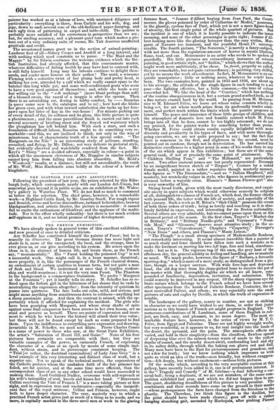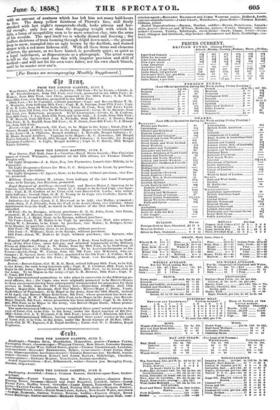THE FRENCH EXHIBITION.
We have already spoken in general terms of this excellent exhibition, and now proceed at once to detailed criticism.
Ary Scheffer has constituted himself the painter of Faust; but he is scarcely its illustrator. The great German drama has more light and shade in it, more of the unexpected, the local, and the strange, than he ever gives us, or can give according to his system. He seizes upon the ideas in it, its abstract of human life, and treats these, as the French say, " monumentally." His " Faust holding the poisoned Cup" is not a successful work. One might call it, in a loose manner, theatrical; more properly, it is, like the personages of the French classical drama, an embodiment of certain qualities in human form, but not quite a man of flesh and blood. We understand at once that it typifies student- ship and world-weariness ; it is not the very man Faust. The Phantom in the background is a commonplace Ossianism. We prefer " Margaret at the Fountain" ; yet it hardly tells its story. M. Scheffer has so re- lined upon the forlorn girl in the bitterness of her shame that he ends by neutralizing the expression altogether ; from the intensity of quietism he passes into quietness. The face looks out calm, mild, and serious, and might mean anything from sensitiveness down to coldness—anything but a sharp passionate pang. And then the contrast is missed, with the op- portunity which it afforded for explaining the incident. The girls who have been gossiping with Margaret, and whose stray shafts of spite against some frail companion have been arrows in her own bosom, are as staid and pensive as herself. There are points of expression and treat- ment to which he who knows the history will attach their true value; but these will not be found except by such as come prepared to find them. Upon the indifference to everything save expression and drawing, invariable in M. Scheffer, we need not dilate. Pierre Charles Comte is a name of power to those who saw, at the Great Paris Exhibition, the artist's " Salutation of Henri III. and Guise." None of his four pictures here certainly are comparable with that ; but they are valuable examples of the power, so eminently Trench, of expressing the character of a class or an epoch by means of some simple inci- dent, without strain, and in picturesque consistent keeping. The "Trial [or rather, the doctrinal examination] of Lady Jane Grey " is a level example of this very interesting and distinct class of work, but a superior one. Not to speak of the technical merits, the expressions of the Catholic prelates whom the unshaken faith of the fair prisoner has foiled, are far quieter, and at the same time more efficient, than the correspondent class of art in any other school would have succeeded in making them. Lord Guildford Dudley, overcome with self-reproach at his wife's intrepidity of soul, kneels and kisses her hand. " Benvenuto Cellini receiving the Visit of Francis I." is a more taking picture at first sight, and in expression true and unobtrusive—especially the insignifi- cant face of the royal mistress ; Cellini and Francis, however, ought both to have deeper character. The easy, masterly way in which a practised French artist gives just as much of a thing as he needs, and no more, is capitally marked in the three anvil men at work in the glaring furnace heat. " Jeanne d'AlLret buying from Jean Pare, the Court- mercer, the gloves poisoned by order of Catharine de' Medici," possesses, in the ghastly, eyeless face of Pare, which yet is not a mere figure-head of atrocity, the best single point of the whole quartett of pictures. But the incident is one of which it is hardly possible to indicate the inner meaning, and none of the other personages is quite right; Jeanne d'Al. bret looking more like the glozing betrayer than the easy victim, Mar- garet of Navarre too innocent, and the youthful Henri IV. unrecog- nizable. The fourth picture, "The Sorceress," is merely a fancy-subject, with not more than the regulation-amount of horror in mystic libation, flame, toad, and cat. Meissonnier is an artist who needs to be spoken of guardedly. His little pictures are extraordinary instances of minute painting, in good artistic style, not" finikin," which shows that the author might work more ambitiously, if he chose. In finish, properly so called, they are remarkable, but not quite extraordinary; in painting, very. skilful, yet by no means the work of a colourist. In fact, M. Meissonnier is an ex- quisite manipulator; little or nothing more, whatever he might have been. The two examples here, painted in 1855 and 1856, are about up to his average; the attitude of the single figure in each tending to a set pose—the lighting effective, but a little common,—the tone of colour somewhat hot. We like the head of the "Courtier," which has nothing of the routine obsequiousness in it, but a certain grand scathed look, as of a fine nature crusted hard by the world. In passing from M. Meissen- nier to M. Edouard Frere, we leave art whose value consists wholly in being art, for art whose worth arises from its profoundly tender senti- ment, and perfect truth within the limits which the painter proposes to himself. The peace and innocence of these little groups of children, and the atmosphere of domestic love and humble content which M. Frere brings into all that he does, cannot be too highly esteemed; we do not say praised, for the painter works for something better than praise. Whether M. Frere could obtain results equally delightful with more diversity and peculiarity in his types of faces, and with more thorough- going execution, we are not quite prepared to say; but the fact that there is sameness in the first, and slightness in the second, must be pointed out in candour, though not in depreciation. He has carried his distinctive excellences to a higher point in some of his works than in any of the six which appear in this exhibition ; but these are of the same general rank, if not at precisely the same point of attainment. The " Children Shelling Peas," and " The Milkmaid," are particularly sweet. Two other eminent names are but poorly represented : Decamps by an insignificant brown sketch of " Zingari ' ; Couture by a naked female model, painted in a rather repulsive though masterly manner, who figures as " The Disconsolate,"—and an " Italian Shepherd," still masterly, but wretchedly vulgar in style, whofi sentimental pen- siveness before a wayside cross. Hamon's "Homan in Flower-girl" also is very unworthy of him. Strong broad truth, given with the most manly directness, and exqui- site nicety in quiet subjects which would otherwise scarcely be subjects at all, distinguish two classes of French art, which deal, the former chiefly with peasant life, the latter with the life of society, and especially of the last century. Such a work as M. Brion's "Sick Child" presents the cream of both these orders of truth ; being as lovely and touching as it is abso- lutely faithful in expression, and interesting for its Breton nationality. Several others are very admirable, but we cannot pause upon them at this advanced period of the season. In the first class, Trayeea "Market-day in Brittany," and " Brittany Needle-girls," and Veyrassat's " Noon- tide Meal," and "Gleaners," deserve most attentive study ; in the se- cond, Trayer's "Convalescent," Chaplin's "Coquetry," Duverger's "New Dress" and others, and Plassan's ` Music Lesson." "The Plough" is a small strong specimen of Mademoiselle Bonhenr, not remarkably interesting. It seems almost incredible that a painter of so much study and fame should have fallen into such a mistake as to make the foremost ox moving his two left legs, fore and hind, simultane- ously : but so it is. The vigorous tug of the oxen, the grey heat of the afternoon sky, the general solidity in feeling and handling, are as masterly as usual. We much prefer, however, the figure of " Barbaro, a favourite sporting-dog," which is more of a mere study, as distinguished from a pic- ture, though on a larger canvass. With wide fore-legs and depressed head, the old dog rises from his clean-picked bone to receive the pat of his master with that thoroughly doglike air which we all know, com- pounded of familiarity, deprecation, invitation, and submission. This could scarcely be improved in any respect. Of the sharp vigorous eye for brute nature which belongs to the French school we have here several other specimens from the hands of Juliette Bonheur, Couturier, the al- most unrivalled Palizzi, and others ; we may especially note the small pictures of cats and eagles by Devine, in which the truth of expression is notable.
The landscapes of the gallery, scanty in number, are not so striking in character as we could have wished to see them, in order that juster notions as to this branch of French art might progress in England. The numerous contributions of M. Lambinet, some of them English in sub- ject, are fresh, easy, and pleasant, in no mean degree. The most re- markable feature here, however, is the series of views by M. T. C. Frere, from Egypt and Palestine. These are not highly wrought works, but very wonderful, as it appears to us, for real insight into the lands of the desert, the pyramid, and the palm. The atmospheric effects are varied, and bold in their simplicity—from the cloudless, flawless spread of deepening blue over the salmon .tawny waste of sands to the yellow depths of sunset, and the murky desert-swirl, confounding land and
in its sultry drifts, through which the baking sun glares red and dull Many men have been to the East for picturesqueness and grandeur, and not a few for truth ; but we know nothing which impresses us with quite so vivid an idea of the truth—seen broadly, but without exaggera- tion—felt deeply, but without excitement—asthese little pictures.
Of the works which, according to the very acceptable custom at this gallery, have recently been added to it, one is of preeminent interest. It is the ' Tragedy and Comedy" of M. Gerome—a duel following a car- nival-ball ; being a duplicate, if we are not mistaken, of the same com- position exhibited last year, and which we did not happen then to see. The quiet, shuddering dreadfulness of this picture is very peculiar. The combatants and their seconds have come on the ground in their masks —whose grotesqueness the facts have changed from the frivolous to the ghastly. The Cherokee, (we think this figure is the duellist, but the point should have Leen made clearer,) goes off with a rather hangdog slouching gait, seconded by Harlequin, after pinking Pierrot with an amount of neatness which has left him not many half-hours to live. The damp yellow faintness of Pierrot's face, still freely enaked with last night's masquerade-chalk, looks piteous and hor- rid enough; only less so than the dragging weight with which he falls, a lump of incapability soon to be mere senseless clay, into the arms of his seconds. The spot itself too is wholly dismal and freezing ; the leafless skeletons of trees looming through frigid dawn-mist,-the ground deep in snow, trampled into an ugly brown by the duellists, and stained deeper with a red more hideous still. With all these items and elements of terror, the picture, as we have hinted, is peculiarly quiet; as quiet as a legal indictment, as dispassionate as a photograph. The artist wants to tell us the facts-and does this with singular precision and skill of method-and will not let his own voice falter, nor his own cheek blanch, until he be master over oar's.
[For BOORS see accompanying Monthly Supplement.]



































 Previous page
Previous page